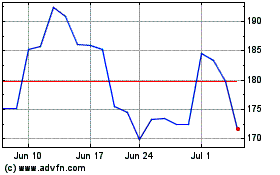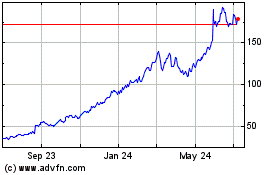US Retail Sales Expected To Show Solid Growth Despite Challenges
February 18 2011 - 2:23PM
Dow Jones News
U.S. retail sales are expected to rise 4% this year, the best
gain since 2006, despite heavy pressures from rising fabric costs
and still-cautious consumers, the industry's biggest trade group
said.
Since the retail industry has enjoyed virtually uninterrupted
growth, the $2.47 trillion total sales for 2011 would represent a
record and reflect a continuing recovery since sales dropped 2.7%
in 2009 during the depths of the recession. The figures, from the
National Retail Federation, don't include auto, gasoline and
restaurant data.
Investors will get a feel for how retailers themselves are
looking at the year when the biggest in the industry report
fourth-quarter results next week and issue outlooks. Wal-Mart
Stores Inc. (WMT), Target Corp. (TGT), Macy's Inc. (M), Sears
Holdings Corp. (SHLD), J.C. Penney Co. (JCP) and Kohl's Corp. (KSS)
are all scheduled to report their data.
While this year's projected retail-sales gain would be better
than the 3% annual growth rate during the past decade and higher
than last year's 3.7% growth, it is below the 5% rate that the NRF
says reflects a strong economy.
The figures are arrived at by looking at various economic
indicators that give a taste for consumer consumption as well as
recent retail performance. The NRF's optimism is fueled by the
retail industry coming off of seven straight months of sales
growth, according to government figures. And holiday sales rose a
"very healthy" 5.7%, the trade group said.
"Consumers have a lot of spending power that they have been
sitting on, as evidenced in part by the strong holiday sales," said
Scott Krugman, vice president at the NRF. Consumers should also
have a bit more money on hand thanks to the Social Security tax
cuts that began in January. On the higher end, the vastly improved
stock market has spurred more buying.
Still there is a lot of pressure coming into 2011. Food
inflation has already kicked in and gasoline prices continue
climbing, matters that cannot be controlled by retailers. They are
also trying to contend with industry-related matters like rising
prices for cotton and other fabrics, and higher manufacturing and
labor costs.
It is a tough job, though. Raw-material inflation is
"extraordinary," said Tracey Travis, chief financial officer at
Polo Ralph Lauren Corp. (RL) during the apparel company's
third-quarter earnings conference call earlier this month.
Citigroup sees apparel costs rising 4% to 6% in the first half
of this year, then jumping 13% to 15% in the second half, which
will eat into profits to varying degrees and likely mean higher
prices for customers in certain cases.
Retailers' game plans involve keeping price increases as low as
possible and finding alternate and cheaper ways of making their
goods without compromising quality. But even they do not yet know
just how high prices will be going because conditions are still in
flux.
"We're taking a stance that is almost week by week (regarding)
what's happening as we are raising prices," said Michael Jefferies,
chief executive of Abercrombie & Fitch Co. (ANF), earlier this
week during the company's earnings call. "We're comfortable that we
can pass some of these increases on to the customer. We're not
comfortable with how much."
-By Karen Talley, Dow Jones Newswires; 212-416-2196;
karen.talley@dowjones.com
Abercrombie and Fitch (NYSE:ANF)
Historical Stock Chart
From May 2024 to Jun 2024

Abercrombie and Fitch (NYSE:ANF)
Historical Stock Chart
From Jun 2023 to Jun 2024
